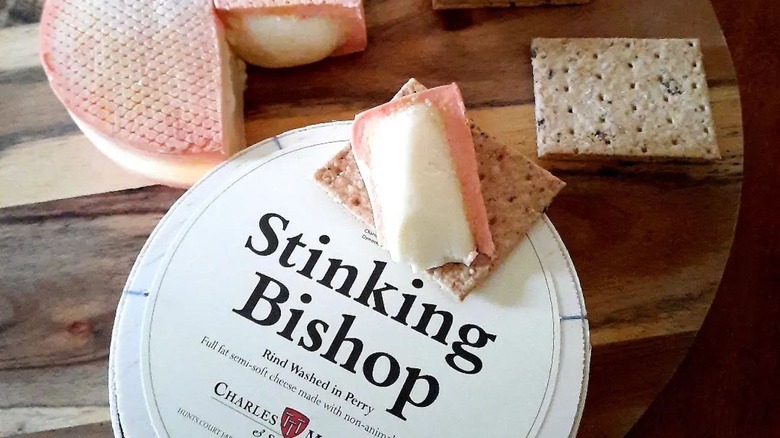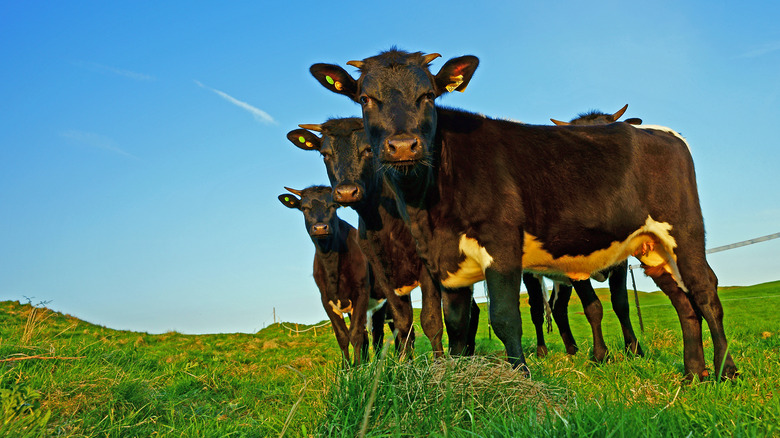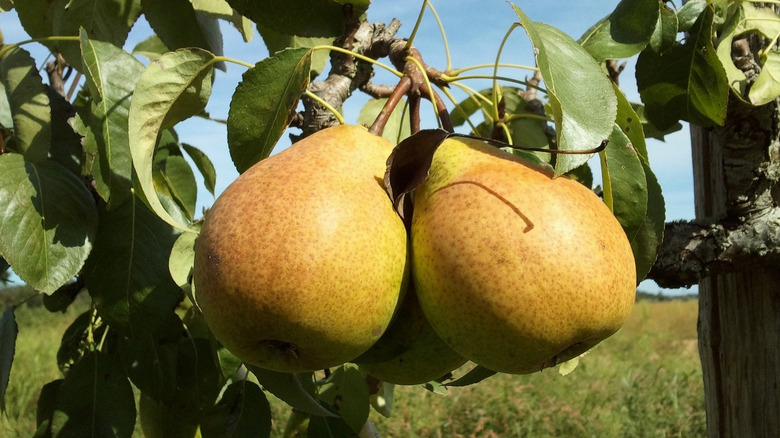Stinking Bishop: The Cheese Named After A Less-Famous Fruit
Some cheeses have a smelly reputation — so much so that "stinky cheese" is practically its own classification. When cheese connoisseurs talk about stinky cheeses, they're generally talking about washed-rind cheeses, like Limburger and Camembert.
But even among the stinkiest of cheeses, some stand out. Stinking Bishop is one such cheese, and it even has the credentials to prove it. In 2009, a panel of judges ruled that Stinking Bishop, a washed-rind cheese made by cheesemakers Charles Martell & Son, was the smelliest cheese in England.
While the cheese isn't readily available in supermarkets, Stinking Bishop has caught England's popular imagination. Its pungent reputation earned it a cameo in "Wallace & Gromit: The Curse of the Were-Rabbit," and it's a popular gag gift among actual bishops. Stinking Bishop is more than just a punchline, though. A testament to the strength of traditional British farmhouse culture, the award-winning cheese comes from a long and varied history of British cheesemaking.
Where did Stinking Bishop originate?
While the U.K. is now known for complex, flavorful cheeses, it hasn't always been that way. British cheesemaking thrived throughout the Middle Ages when monks traded recipes with monasteries in France, but World War II devastated the industry. During the war, the government rationed cheeses, limiting the number of varieties that cheesemakers could produce. While these cheeses were healthy — the Ministry of Food held rations to a high nutritional standard — they weren't particularly tasty.
After the war, British cheese was in crisis. From 1939 to 1974, 300 British cheesemakers ceased operation, leaving just 33 farms producing the country's once-famous cheddar. But things were changing. A new generation of cheesemakers began to revive traditional techniques, ushering in an era of British cheesemaking known as "the Great Cheese Renaissance."
In 1972, Charles Martell bought Hunts Court Farm in Gloucestershire, England. He had a mission: to revive a dying breed of cattle, Old Gloucester cows. Shortly after Martell bought his farm, Patrick Rance, a pioneer of British cheesemaking, sent him a blank check to start producing cheese. Martell didn't know much about cheese, but in 1973, his first cheese was featured on the BBC program "Taste of England."
Inspired by traditional techniques, Martell developed Stinking Bishop in 1994. But it wasn't until 2005 when the cheese was featured in "Wallace and Gromit," that it became a bestseller. Overnight, Martell was swamped with orders. Now, it's one of England's most famous cheeses, found in specialty shops around the country.
How did Stinking Bishop get its name?
While Stinking Bishop's name is apt, it's a bit misleading. The cheese gets its name from the stinking bishop pear, also known as the Moorcroft pear. The small, inedible pears, closely related to wild pears, were domesticated around 1400 in England's Wye Valley. They're used to make perry, a type of alcoholic cider.
Despite their name, the pears themselves don't stink. They're named for Frederick Bishop, a 19th-century farmer and a local legend. Bishop was, purportedly, a drunkard with a nasty temper and questionable hygiene. His foul reputation earned him the nickname "Stinking Bishop," and the moniker stuck — not only to the man but also to the pears he grew. Bishop's temper may have been sour, but Stinking Bishop pears are sweeter than most perry pears — perfect for cider.
Now, the cheesemakers at Charles Martell & Son use perry made from these pears to wash the outside of Stinking Bishop cheese as it ages. The perry is made on the Charles Martell & Son estate using a distillery dating back to 1650, the oldest in the British Isles. It's available for purchase on its own, along with other spirits like brandy and poireau.
How is Stinking Bishop made?
While Stinking Bishop may not have a direct relation to actual bishops, its history is liked to that of the clergy. The history of European cheesemaking has long been associated with medieval monasteries. Monks first invented washed-rind cheeses in the Middle Ages, and Stinking Bishop was originally inspired by cheeses made by the Cistercian monks who once farmed Charles Martell's land.
According to legend, washed-rind cheeses were invented by accident when a monk noticed mold growing on the surface of aging cheese. He wiped away the mold and attempted to sanitize the cheese with a combination of alcohol, but no luck — the mold grew back. Frustrated, the monk tried to sanitize the cheese again and again. But instead of the mild, brie-like cheese he'd been attempting to make, he ended up with foul-smelling — but surprisingly delectable — orange rounds.
Stinking Bishop is made in much the same way. While Charles Martell & Son keep aspects of the process hush-hush, they have divulged some of their secrets. The first step of the process fermenting pasteurized milk from local Gloucester cows with vegetable rennet until it forms curds. The curds are then packed into beech wood molds. After one day, when it's firm enough to hold its shape but soft enough to absorb the flavors of the perry, the cheese is bathed in perry. From there, the cheese is aged for two to three weeks before being sold to customers.
What does Stinking Bishop taste like?
Covering the 2009 event where it was honored, The Independent reported that the panel of judges who originally crowned Stinking Bishop the smelliest cheese in England likened it to "a rugby club changing room." Words like "putrid," "sweat," and "dirty socks" are often used to describe the stink. Notice a sweaty theme? There's a reason. Washed-rind cheeses like Stinking Bishop get their smell from Brevibacterium linens, the same bacteria found in sweat.
But you shouldn't judge a book by its cover — or a block of cheese by its smell. Despite the fact that Charles Martell told NPR that "90 percent of people will think it's disgusting," Stinking Bishop has its share of fans. The cheese may be best known for its famous funk, but those who dare taste it rave about the flavor. Even pro-cheese critics agree: Stinking Bishop has won international cheese awards.
Often described as surprisingly mild, the creamy cheese has a nutty and slightly sweet taste. It spreads easily on bread, or you can serve it with pears to complement the taste of the perry cider. Charles Martell & Son suggest serving it on a cheeseboard with fellow cheese Stilton. Naturally, it's up to you to decide if you have the courage to serve it to party guests.




